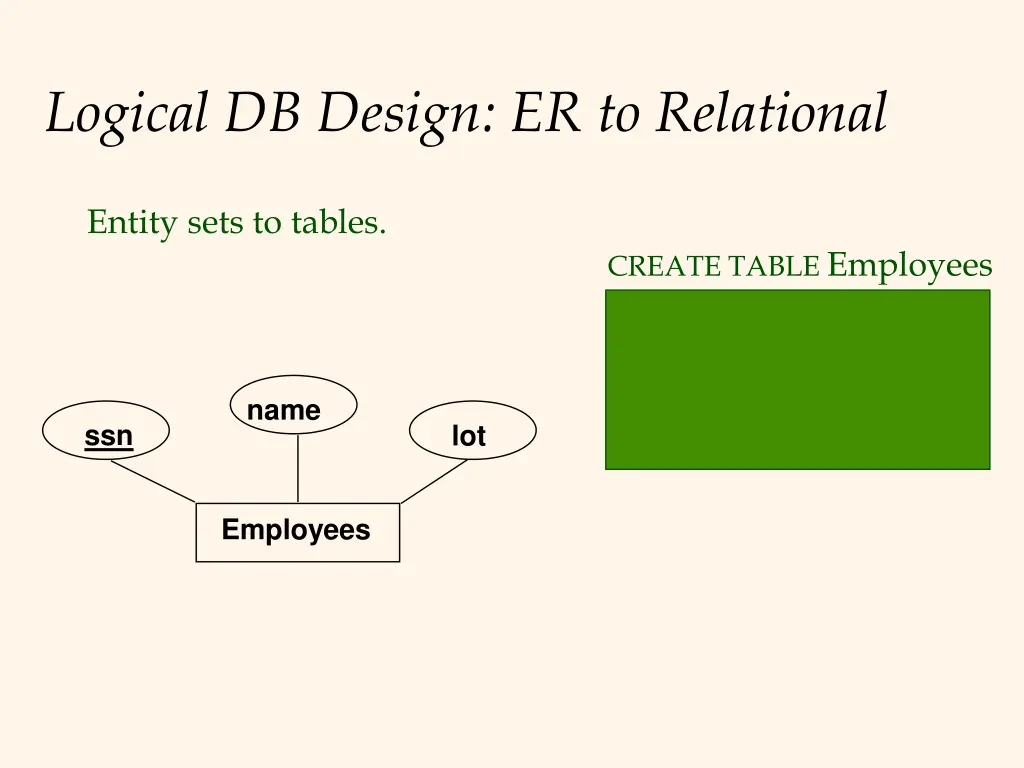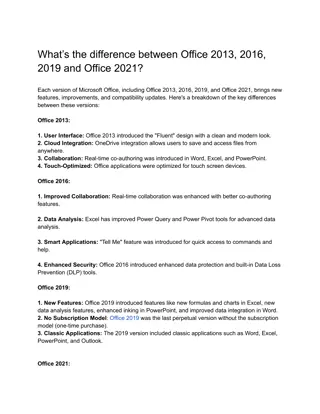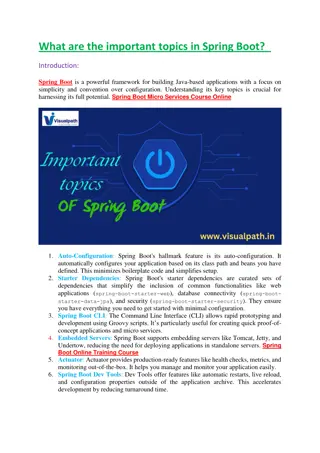
Database Design: Converting Entity Relationship Diagrams to Relational Tables
Explore the process of converting ER diagrams to relational tables for effective database design. Learn how to create tables for entities like Employees and establish relationships such as Works_in between Employees and Departments.
Download Presentation

Please find below an Image/Link to download the presentation.
The content on the website is provided AS IS for your information and personal use only. It may not be sold, licensed, or shared on other websites without obtaining consent from the author. If you encounter any issues during the download, it is possible that the publisher has removed the file from their server.
You are allowed to download the files provided on this website for personal or commercial use, subject to the condition that they are used lawfully. All files are the property of their respective owners.
The content on the website is provided AS IS for your information and personal use only. It may not be sold, licensed, or shared on other websites without obtaining consent from the author.
E N D
Presentation Transcript
Logical DB Design: ER to Relational Entity sets to tables. CREATE TABLE Employees (ssn CHAR(11), name CHAR(20), lot INTEGER, PRIMARY KEY (ssn)) name ssn lot Employees
Logical DB Design: ER to Relational Entity sets to tables. CREATE TABLE Employees (ssn CHAR(11), name CHAR(20), lot INTEGER, PRIMARY KEY (ssn)) name ssn lot Employees
Logical DB Design: ER to Relational Entity sets to tables. CREATE TABLE Employees (ssn CHAR(11), name CHAR(20), lot INTEGER, PRIMARY KEY (ssn)) name ssn lot Employees
Relationship Sets to Tables since name dname budget ssn lot did Employees Works_in Departments CREATE TABLE Works_In( ssn CHAR(1), did INTEGER, since DATE, PRIMARY KEY (ssn, did), FOREIGN KEY (ssn) REFERENCES Employees, FOREIGN KEY (did) REFERENCES Departments) What type of relationship is this? 1. One-to-one 2. One-to-many 3. Many-to-one 4. Many-to-many
Relationship Sets to Tables since name dname budget ssn lot did Employees Works_in Departments CREATE TABLE Works_In( ssn CHAR(1), did INTEGER, since DATE, PRIMARY KEY (ssn, did), FOREIGN KEY (ssn) REFERENCES Employees, FOREIGN KEY (did) REFERENCES Departments)
Relationship Sets to Tables since name dname budget ssn lot did Employees Works_in Departments CREATE TABLE Works_In( ssn CHAR(1), did INTEGER, since DATE, PRIMARY KEY (ssn, did), FOREIGN KEY (ssn) REFERENCES Employees, FOREIGN KEY (did) REFERENCES Departments)
Relationship Sets to Tables since name dname budget ssn lot did Employees Works_in Departments CREATE TABLE Works_In( ssn CHAR(1), did INTEGER, since DATE, PRIMARY KEY (ssn, did), FOREIGN KEY (ssn) REFERENCES Employees, FOREIGN KEY (did) REFERENCES Departments)
Relationship Sets to Tables since name dname budget ssn lot did Employees Works_in Departments CREATE TABLE Works_In( ssn CHAR(1), did INTEGER, since DATE, PRIMARY KEY (ssn, did), FOREIGN KEY (ssn) REFERENCES Employees, FOREIGN KEY (did) REFERENCES Departments)
Relationship Sets to Tables since name dname budget ssn lot did Employees Works_in Departments In translating a relationship set to a relation, attributes of the relation must include: Keys for each participating entity set (as foreign keys). All descriptive attributes. v CREATE TABLE Works_In( ssn CHAR(1), did INTEGER, since DATE, PRIMARY KEY (ssn, did), FOREIGN KEY (ssn) REFERENCES Employees, FOREIGN KEY (did) REFERENCES Departments)
Review: Key Constraints since name Each dept has at most one manager, according to the key constraint on Manages. dname budget ssn lot did Employees Manages Departments Translation to relational model? 1-to-1 1-to Many Many-to-1 Many-to-Many
Review: Key Constraints since name Each dept has at most one manager, according to the key constraint on Manages. dname budget ssn lot did Employees Manages Departments CREATE TABLE Manages( ssn CHAR(11), did INTEGER, since DATE, PRIMARY KEY (did), FOREIGN KEY (ssn) REFERENCES Employees, FOREIGN KEY (did) REFERENCES Departments) Translation to relational model?
Review: Key Constraints since name Each dept has at most one manager, according to the key constraint on Manages. dname budget ssn lot did Employees Manages Departments CREATE TABLE Dept_Mgr( did INTEGER, dname CHAR(20), budget REAL, ssn CHAR(11), since DATE, PRIMARY KEY (did), FOREIGN KEY (ssn) REFERENCES Employees) Since each department has a unique manager, we could instead combine Manages and Departments.
Review: Participation Constraints v Does every department have a manager? If so, this is a participation constraint: the participation of Departments in Manages is said to be total (vs. partial). u Every did value in Departments table must appear in a row of the Manages table (with a non-null ssn value!) since since name name dname dname ssn did did budget budget lot Departments Employees Manages Works_In since
Participation Constraints in SQL v We can capture participation constraints involving one entity set in a binary relationship, but little else (without resorting to CHECK constraints). CREATE TABLE Dept_Mgr( did INTEGER, dname CHAR(20), budget REAL, ssn CHAR(11) NOT NULL, since DATE, PRIMARY KEY (did), FOREIGN KEY (ssn) REFERENCES Employees, ON DELETE NO ACTION)
Review: Weak Entities v A weak entity can be identified uniquely only by considering the primary key of another (owner) entity. Owner entity set and weak entity set must participate in a one-to-many relationship set (1 owner, many weak entities). Weak entity set must have total participation in this identifying relationship set. name cost pname age ssn lot Policy Dependents Employees
Weak Entities Weak entity set and identifying relationship set are translated into a single table. When the owner entity is deleted, all owned weak entities must also be deleted. name cost pname age ssn lot Policy Dependents Employees
Weak Entities CREATE TABLE Dep_Policy ( pname CHAR(20), age INTEGER, cost REAL, ssn CHAR(11) NOT NULL, PRIMARY KEY (pname, ssn), FOREIGN KEY (ssn) REFERENCES Employees, ON DELETE CASCADE) name cost pname age ssn lot Policy Dependents Employees
name ssn lot Review: ISA Hierarchies Employees hours_worked hourly_wages ISA As in C++, or other PLs, attributes are inherited. If we declare A ISA B, every A entity is also considered to be a B entity. contractid Contract_Emps Hourly_Emps Overlap constraints: Can Joe be an Hourly_Emps as well as a Contract_Emps entity? (Allowed/disallowed) Covering constraints: Does every Employees entity also have to be an Hourly_Emps or a Contract_Emps entity? (Yes/no)
Translating ISA Hierarchies to Relations v General approach: 3 relations: Employees, Hourly_Emps and Contract_Emps. u Hourly_Emps: Every employee is recorded in Employees. For hourly emps, extra info recorded in Hourly_Emps (hourly_wages, hours_worked, ssn); must delete Hourly_Emps tuple if referenced Employees tuple is deleted). u Queries involving all employees easy, those involving just Hourly_Emps require a join to get some attributes. v Alternative: Just Hourly_Emps and Contract_Emps. Hourly_Emps: ssn, name, lot, hourly_wages, hours_worked. Each employee must be in one of these two subclasses.
Draw the ER diagram for the following application v There are football teams, and players. Each football player has a name, surname, age, and role. You may assume that football players have distinct name- surname combinations. Teams have names, coaches, and sponsors. Names of the teams are unique. Football players belong to teams during a period identified by start and end date. A team may have multiple players, but a player belongs to only one team. Games are played among teams, at different cities, and at different dates. A team may play multiple games with another team at different dates. But two teams and a date identify a game. Database Management Systems, R. Ramakrishnan and J. Gehrke 20
Review: Binary vs. Ternary Relationships ssn name pname lot age v If each policy is owned by just 1 employee: Key constraint on Policies would mean policy can only cover 1 dependent! v What are the additional constraints in the 2nd diagram? Dependents Employees Covers Bad design Policies policyid cost name pname age ssn lot Dependents Employees Purchaser Beneficiary Better design Policies policyid cost
Binary vs. Ternary Relationships (Contd.) CREATE TABLE Policies ( policyid INTEGER, cost REAL, ssn CHAR(11) NOT NULL, PRIMARY KEY (policyid). FOREIGN KEY (ssn) REFERENCES Employees, ON DELETE CASCADE) CREATE TABLE Dependents( pname CHAR(20), age INTEGER, policyid INTEGER, PRIMARY KEY (pname, policyid). FOREIGN KEY (policyid) REFERENCES Policies, ON DELETE CASCADE) v The key constraints allow us to combine Purchaser with Policies and Beneficiary with Dependents. v Participation constraints lead to NOT NULL constraints.
Relational Model: Summary v A tabular representation of data. v Simple and intuitive, currently the most widely used. v Integrity constraints can be specified by the DBA, based on application semantics. DBMS checks for violations. Two important ICs: primary and foreign keys In addition, we always have domain constraints. v Powerful and natural query languages exist. v Rules to translate ER to relational model






















